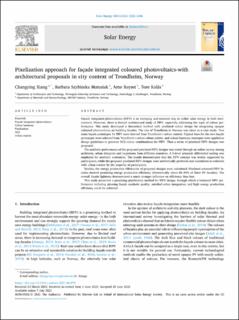| dc.contributor.author | Xiang, Changying | |
| dc.contributor.author | Matusiak, Barbara Szybinska | |
| dc.contributor.author | Røyset, Arne Karstein | |
| dc.contributor.author | Kolås, Tore | |
| dc.date.accessioned | 2021-11-15T08:40:31Z | |
| dc.date.available | 2021-11-15T08:40:31Z | |
| dc.date.created | 2021-07-07T22:28:11Z | |
| dc.date.issued | 2021 | |
| dc.identifier.citation | Solar Energy. 2021, 224 1222-1246. | en_US |
| dc.identifier.issn | 0038-092X | |
| dc.identifier.uri | https://hdl.handle.net/11250/2829511 | |
| dc.description.abstract | Façade integrated photovoltaics (FIPV) is an emerging and essential way to utilize solar energy in built environment. However, there is limited architectural study of FIPV, especially addressing the topic of colour performance. This study developed a theoretical method with pixelated colour design for integrating opaque coloured photovoltaics on building facades. The city of Trondheim in Norway was taken as a case study. Two main façade prototypes for FIPV were derived from Trondheim’s urban context. Typical hues for the two façade prototypes were selected from Trondheim’s urban colour palette, and colour harmony strategies were applied as design guidelines to generate NCS colour combinations for FIPV. Then a series of pixelated FIPV designs was proposed. The aesthetic performance of the proposed pixelated FIPV designs was tested through an online survey among architects, urban designers and laypersons from different countries. A 5-level semantic differential scaling was employed for aesthetic evaluation. The results demonstrated that the FIPV concept was widely supported by participants, while the proposed pixelated FIPV designs were aesthetically preferred and considered as coherent with urban context by the majority of participants. Besides, the energy production efficiencies of proposed designs were calculated. Pixelated coloured FIPV facades showed promising energy production efficiency (theoretically about 85–93% of black PV facades). The overall façade lightness demonstrated a much stronger influence on efficiency than hue. This study presented a promising pixelization method for FIPV design, through which a balanced FIPV performance including pleasing façade aesthetic quality, satisfied urban integration, and high energy production efficiency could be achieved. | en_US |
| dc.language.iso | eng | en_US |
| dc.publisher | Elsevier | en_US |
| dc.subject | Urban context | en_US |
| dc.subject | NCS | en_US |
| dc.subject | Pixelization | en_US |
| dc.subject | Colour harmony | en_US |
| dc.subject | Façade integrated photovoltaics | en_US |
| dc.title | Pixelization approach for façade integrated coloured photovoltaics-with architectural proposals in city context of Trondheim, Norway | en_US |
| dc.type | Peer reviewed | en_US |
| dc.type | Journal article | en_US |
| dc.description.version | publishedVersion | en_US |
| dc.rights.holder | © 2021 The Author(s). Published by Elsevier Ltd on behalf of International Solar Energy Society. | en_US |
| dc.source.pagenumber | 1222-1246 | en_US |
| dc.source.volume | 224 | en_US |
| dc.source.journal | Solar Energy | en_US |
| dc.identifier.doi | 10.1016/j.solener.2021.06.079 | |
| dc.identifier.cristin | 1920865 | |
| cristin.ispublished | true | |
| cristin.fulltext | original | |
| cristin.qualitycode | 2 | |
